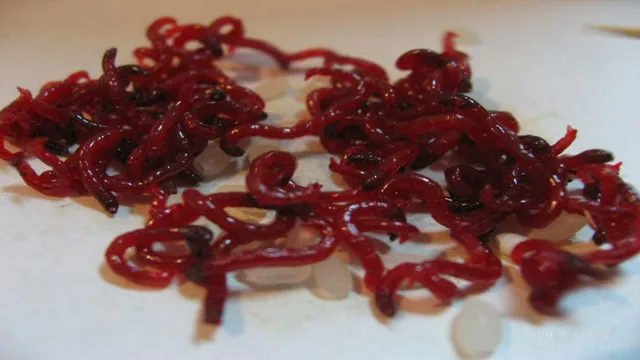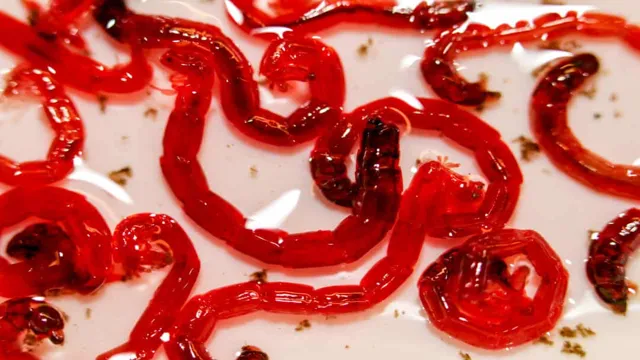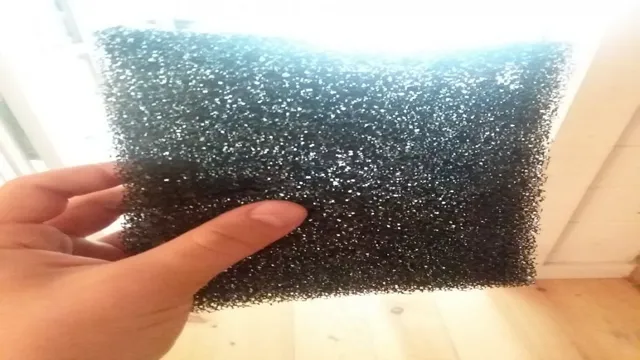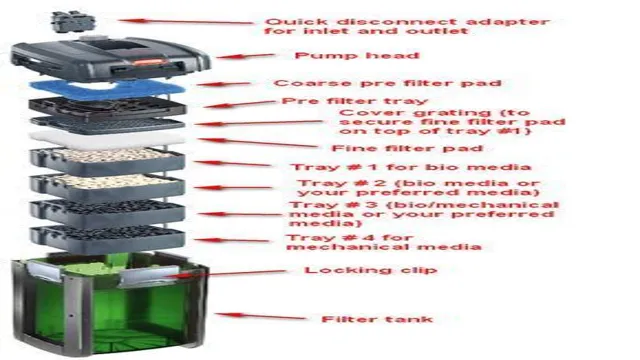Looking for a way to get rid of bloodworms in your aquarium can be a daunting task for any aquarium owner. These tiny red worms can multiply quickly in your tank and become a nuisance to your aquatic life. Bloodworms exist in various forms and can infest your tank quickly, leading to a decline in your fishes’ health.
But worry not, we’ve got you covered! With our guide, we’ll show you the effective ways to eliminate bloodworms and keep them from coming back. Don’t let these pesky creatures take over your aquarium and ruin your aquatic paradise!
What are Bloodworms?
Bloodworms are small, worm-like creatures that are commonly found in aquariums. They are a type of aquatic insect larvae that feed on decaying matter in the water. While they are not harmful to fish, they can be unsightly and annoying for aquarium owners.
To get rid of bloodworms in your aquarium, it is important to first clean the tank thoroughly, removing any decaying matter or debris that could be attracting the creatures. You can also use a commercial product designed to kill bloodworms, or introduce natural predators such as certain types of fish or insects to the tank. Regular water changes and maintenance can also help prevent the growth of bloodworm populations in your aquarium.
By taking the right steps, you can keep bloodworms under control and maintain a healthy and attractive aquarium for your fish.
Description
Bloodworms are a type of aquatic invertebrate that are commonly used as bait in fishing. They are the larvae of various species of midges and are typically found in the muddy bottom of water bodies such as lakes and rivers. These small, red-colored worms get their name from their bright red blood-like pigment that gives them a distinct appearance.
Bloodworms are a popular choice for bait because they emit a scent that is irresistible to many fish species. Not only are they effective in attracting fish, but they are also easily accessible and relatively inexpensive compared to other types of bait. Despite their small size, bloodworms have a big impact on the fishing industry and continue to be a staple for avid anglers looking to catch their next big fish.

Effects on Aquarium and Fish
Bloodworms are a type of aquatic worm commonly found in freshwater ponds and aquariums. These worms are a popular source of food for many aquarium fish species, including bettas, guppies, and tetras. Bloodworms are known for their bright red color, which comes from the hemoglobin in their blood.
They are usually freeze-dried or sold in gel form for easy feeding. However, bloodworms should be used sparingly, as they can be quite rich and may cause digestive issues if overfed. These worms are also known to have a high burstiness factor, meaning they can quickly decompose and negatively impact water quality if not consumed by fish.
It’s important to carefully monitor the amount of bloodworms given to fish to avoid any negative effects on the overall health of the aquarium.
Preventing Bloodworm Infestation
Bloodworms can be a pesky problem in aquariums, but there are steps you can take to prevent infestations. One of the best ways to keep bloodworms from taking over your aquarium is to maintain good water quality. Regular water changes and proper filtration can help keep the water clean and reduce the chances of bloodworms appearing. (See Also: Why Do Aquariums Have Blue Lights: The Science Behind This Popular Practice)
Another key factor is to avoid overfeeding your fish, as excess food can lead to an increase in waste and debris in the tank, providing a perfect breeding environment for bloodworms. Additionally, consider adding fish or other aquatic creatures that feed on bloodworms, such as catfish or loaches, to help keep the population under control. By taking these simple steps, you can help prevent bloodworms from becoming a nuisance in your aquarium.
Avoid Overfeeding Your Fish
When it comes to caring for your aquatic pets, it’s essential to know the right amount of food to give them to prevent overfeeding and health problems. Overfeeding your fish can lead to a build-up of excess nutrients in the tank, which can cause an infestation of unwanted organisms like bloodworms. Bloodworms are tiny, red worms that can quickly multiply and take over your tank, leading to poor water quality and potential harm to your fish.
To prevent this, it’s essential to feed your fish small amounts multiple times a day and remove any uneaten food within a few minutes. By controlling your feeding habits and keeping a clean tank, you can avoid a bloodworm infestation and ensure your fish are healthy and happy. Remember, it’s better to underfeed than overfeed when it comes to your aquarium pets.
Maintain Good Water Quality
Maintaining good water quality is essential when it comes to preventing a bloodworm infestation in your aquarium. Bloodworms are a type of larvae that can quickly multiply and cause havoc in your fish tank, wreaking havoc on the aquatic life. To prevent this from happening, you need to keep your aquarium clean, well-filtered, and oxygenated.
Regular water changes are also crucial in maintaining water quality, helping to remove excess debris and waste that can lead to bloodworm infestations. Moreover, using high-quality food and avoiding overfeeding prevent uneaten food from breaking down and creating unhealthy water conditions. Keeping a clean aquarium with good water quality promotes the growth of healthy bacteria that break down harmful waste and promote a sustainable environment for your fish.
By maintaining good water quality, you’re taking a significant step towards preventing bloodworm infestation and preserving the health and wellbeing of your aquatic pets.
Regular Tank Maintenance
As fish enthusiasts, we all know how important it is to maintain the cleanliness of our tanks. One issue that can arise if regular maintenance is neglected is a bloodworm infestation. Bloodworms are the offspring of a type of midge fly and can quickly take over a tank if not dealt with promptly.
To prevent this unpleasant scenario, it’s important to regularly change the water in your tank and vacuum the gravel to remove any debris that may collect on the bottom. Another effective way to prevent bloodworm infestation is to avoid overfeeding your fish, as excess food can accumulate and create the perfect environment for bloodworm eggs to hatch. By staying on top of your tank’s maintenance and keeping it clean, you can ensure that your fish will live in a healthy and happy environment, free from pesky bloodworms.
Getting Rid of Bloodworms
Do you have bloodworms infesting your aquarium? These tiny, red larvae can be a nuisance and harmful to your fish. One way to get rid of bloodworms is by removing any decaying organic matter and performing regular water changes. Bloodworms thrive in poor water quality, so ensuring a clean environment can help prevent their growth.
Another effective method is using a product specifically designed to eliminate bloodworms, such as a pesticide-free treatment. Be sure to follow the instructions carefully and remove any dead bloodworms to prevent water contamination. Lastly, adding natural predators like loaches or small fish can help keep bloodworm populations under control.
With these tips and a little patience, you can get rid of bloodworms and maintain a healthy aquarium for your fish to thrive in. (See Also: How to Change Fish in Aquarium on Ship Warframe: Step-by-Step Guide)
Manual Removal
Bloodworms can be a pesky problem for aquarium owners. One effective way of getting rid of them is through manual removal. This method involves physically removing the bloodworms from the tank using tools such as tweezers or a net.
To prevent bloodworms from reaching their adult stage, it’s important to remove the larvae as soon as possible. Additionally, implementing a regular tank maintenance schedule can help prevent the buildup of organic matter that bloodworms often feed on. While manual removal can be time-consuming, it’s a great way to ensure that your aquarium stays clean and free from bloodworm infestations.
By using this method regularly, you can maintain a healthy and thriving aquarium for your aquatic pets.
Chemical Treatments
Bloodworms can be a source of frustration for aquarium owners due to their ability to multiply rapidly, causing harm to the fish if left unchecked. One way to get rid of them is through the use of chemical treatments. These can be found in the form of liquid and tablet forms that contain active ingredients such as trichlorfon and levamisole.
However, caution must be exercised when using these treatments as some fish may be sensitive to the chemicals. It’s best to research the type of treatment suitable for your aquarium and follow instructions carefully. In addition, frequent water changes and feeding schedules can also help to reduce their population.
At the end of the day, regular maintenance and observation will keep your aquarium free from bloodworms and provide a healthy environment for your fish.
Biological Approach
Bloodworms, Biological Approach If you’re dealing with pesky bloodworms in your fish tank, you may be wondering how to get rid of them. A biological approach can be an effective, natural solution for tackling bloodworms. One option is adding a predator to your tank, such as a freshwater shrimp or certain types of snails, that will feed on the bloodworms and keep them under control.
Additionally, introducing beneficial bacteria to your tank’s ecosystem can help break down waste and improve water quality, making it less hospitable to bloodworms. Regular water changes and maintaining a clean tank can also discourage bloodworms from taking hold. By taking a natural, biological approach to bloodworms, you can eliminate the problem without harmful chemicals or treatments that may harm your fish.
Conclusion
When faced with the creepy crawly menace that is the bloodworm, many aquarium owners may feel overwhelmed. But fear not! With a few simple steps and a little patience, you can rid your tank of these pesky critters. Just remember: vacuum your substrate regularly, feed your fish only what they can eat in a few minutes, and try not to overstock your tank.
And if all else fails, just remember the wise words of Dory: just keep swimming, just keep swimming, just keep swimming…away from the bloodworms, that is!” (See Also: How to Change Polyester Aquarium Filter in 7 Easy Steps: A Step-by-Step Guide)
FAQs
What are bloodworms and how do they affect aquariums?
Bloodworms are the larvae of a type of midge fly, and they can be harmful to aquariums because they consume organic matter and release ammonia into the water, which can be toxic to fish.
How do bloodworms enter an aquarium?
Bloodworms can enter an aquarium by hitchhiking on live plants or being present in frozen or live food that is fed to the fish.
Can bloodworms harm fish in the aquarium?
Yes, bloodworms can harm fish in the aquarium if their population is not controlled. They can deplete the oxygen levels in the water and contribute to the growth of harmful bacteria.
What is the best way to remove bloodworms from an aquarium?
The best way to remove bloodworms from an aquarium is to perform a thorough vacuuming of the substrate, remove any dead or decaying plant matter, and decrease the amount of food being fed to the fish.
Are there any natural predators of bloodworms in an aquarium?
Yes, some fish species such as loaches and gouramis are known to eat bloodworms and can help control their population in the aquarium.
Can chemicals be used to eliminate bloodworms from an aquarium?
Yes, some aquarium-safe chemicals such as fenbendazole and Levamisole can be used to eliminate bloodworms from an aquarium, but they should be used with caution and according to the manufacturer’s instructions.
How can the risk of introducing bloodworms to an aquarium be minimized?
The risk of introducing bloodworms to an aquarium can be minimized by quarantining any new live plants and freezing or blanching any new live or frozen food before feeding it to the fish.







